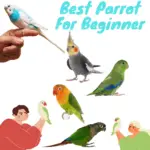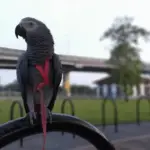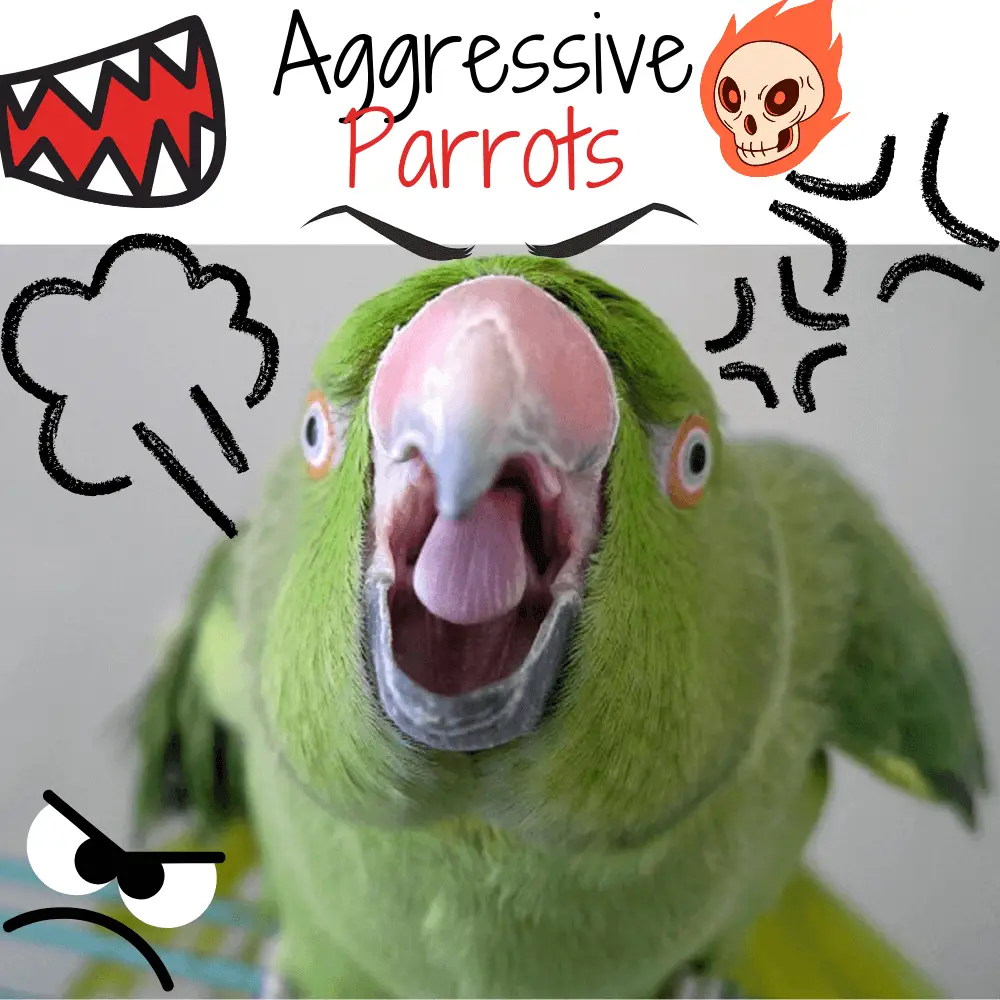
Aggressive Parrots Your parrot should be given the power to make decisions, otherwise, it is likely to become aggressive, overexcited, and/or bite you.
10 Ways to Deal with an Aggressive Parrot
SOURCE:AnimalWonders Montana
Aggressive Parrots, Any pet, including a parrot, has moods and desires. You should let your parrot have the power to make decisions whenever possible. Speak softly and invite them to join you. If he doesn’t seem inclined to run, then ask yourself if it is really NECESSARY to take your parrot at that time. If the answer is no, don’t insist and try again at another time. If on the contrary you absolutely must take it without further delay, I advise you to attract it to you using the short distance recall command. Follow the method proposed HERE to teach him this command. It is not recommended to use the “climb” command which will invade your parrot’s personal space at a time when it does not want to be disturbed. You would risk earning a nice bite and at the same time teach him to communicate his moods with you in this way!
2- Always have a gentle and calm attitude when handling your parrot. If you are angry, rushed, or upset, he will perceive it.
Parrots are extremely empathetic and they tend to absorb our emotions, like real sponges. If you are calm, he will do the same for you. If on the contrary, you are angry or elated, it is highly likely to become aggressive, overexcited and/or bite you.
3- Avoid letting your parrot access your shoulder or your head.
Naturally, all parrots will be inclined to choose these places, quite simply because they prefer to perch in height as they do in their natural habitat. However, I advise you not to let your parrot do so, at least until you have developed a relationship of absolute trust with it. Not because a parrot perched on the shoulder will be more dominant (this is a myth), but simply for safety reasons. When your parrot is on your shoulder or your head, you do not see its body language and therefore will not be able to react to it effectively. If something suddenly scares or annoys you, you may end up with a bite in the face. Take my word for it, an earlobe, a pierced lip or nose, it happens very quickly and not just to others! If your parrot lands on your shoulder or head, remove it by using the short distance recall command or by attracting it elsewhere with the target.
4- When your parrot is on you, always remember to offer it good support for its legs.
For example, you can’t expect a large cockatoo to be comfortable with just one finger of your hand! If you have a large parrot, first mount it on the palm of your hand, then let it rest on your forearm. If it’s a medium parrot, you can present it with the palm, the side of your hand, or two fingers. For a small parrot, a single finger will be perfectly suitable. At all times, you should make sure to offer horizontal support, not tilt. In addition, parrots of all sizes will generally like to rest on your legs if you are sitting.
5- Never take your parrot by force, pushing its belly with the finger, peeling its legs off the perch, or under threat by frightening it with a towel.
If you absolutely have to take it right away, I advise you to attract it to yourself using the short distance recall command.
6- Do not make sudden movements when your parrot is on or near you.
We don’t always realize how terrifying and destabilizing a hand that gestures while speaking or an arm that suddenly moves while walking. Admittedly, a parrot has good claws to grip you firmly, but there are still limits to the jerks that it can support before falling! Likewise, some people mistakenly believe that moving their arms or hands up and down to flap their parrot is a game they enjoy. This is rarely the case since your parrot has no control over the situation and the flapping of the wings is simply an instinctive reaction to try to rebalance without suddenly falling to the ground.
7- Never forcibly hold your parrot on you, for example by pinching its legs with one of your fingers when you have it on the hand.
8- Avoid taking your parrot by grabbing it by the back.
These are the predators who act in this way with them to possibly make their feast, so your parrot may react aggressively to this gesture which it will instinctively interpret as a threat to its life.
9- Never force your parrot to go on the visit, or on a family member he does not like.
The relationship you share with your parrot is unique and not built in a few hours. He has learned to trust you gradually and so must everyone else. Respect his rhythm.
How to Train Parrots to Stop Biting
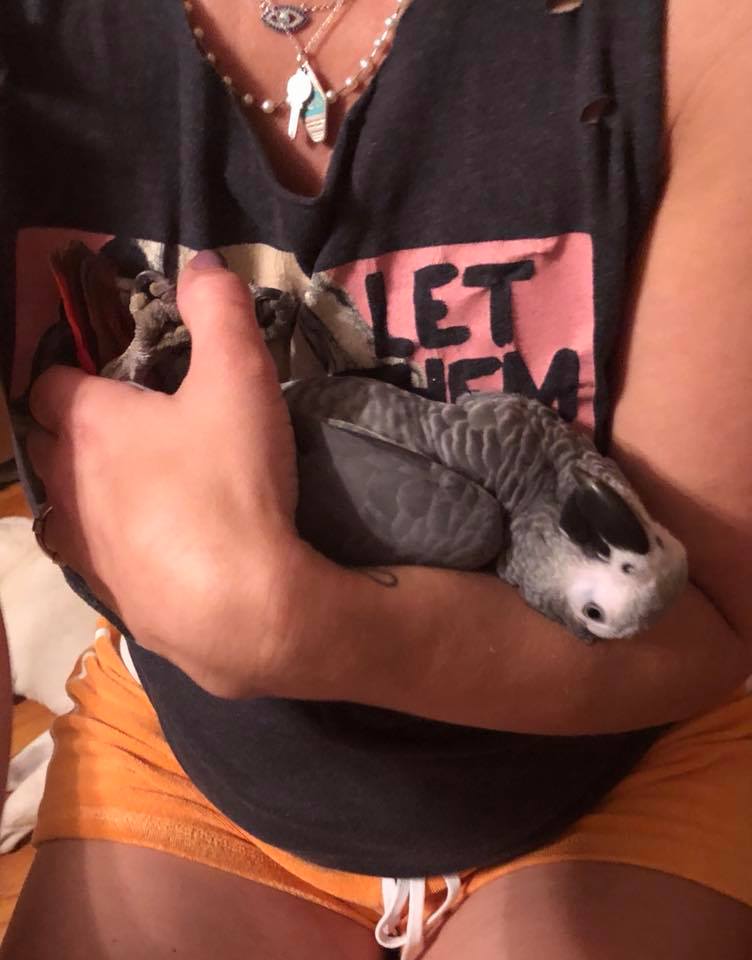
Aggressive Parrots
Some parrots, especially sexually mature individuals, can become extremely aggressive, both towards their humans and their fellow humans. They can attack “compulsively” and inflict painful bites, even outright kill another bird, or disfigure a human being. Several species and groups of species are predisposed to express excessively violent behavior. However, this genetic predisposition does not excuse and does not explain everything.
There are several social and environmental factors that inevitably encourage birds, and in particular certain profiles, to sink into the most total psychopathy.
Hannibal Play the return, parrot version!
Parrots have every reason to express agonistic behavior towards their bird and human partners. These behaviors are an integral part of the social dynamics of a group.
Individuals can enter into conflicts to defend their territory for example (certain groups of species are very territorial), defend their partner (certain species are very “possessive”), their nesting and feeding site, their dormitory, interesting places to explore … etc.
Except that, in a balanced social group and in a “normal” (natural) context, conflicts will always remain soft and will stop most of the time with intimidation.
This is what the famous prevention signals for parrots are used for. Their role is to warn of an imminent attack if the individual to whom the message is intended understands and adjusts their response favorably.
The precepts of life in the wild allow animals to avoid situations that would cause unnecessary energy expenditure and are harmful to their survival. Thus, it should be understood that when the bird decides to attack, even if he does it violently, it is because he will have considered the interest and the necessity of carrying out the attack. He will not attack for other reasons than those which justified the behavior at this moment.
It is the same in captivity, despite the fact that our parrots do not, a priori, have to worry about their survival or their energy expenditure. Simply because these rules are deeply ingrained and immutable. It is the same for all living beings, including humans. In general, we prefer to opt for ease for optimal physical and psychological comfort.
Parrots, therefore, remain in favor of the slightest effort. The expression of a given behavior will ALWAYS be justified by the benefit that the bird can draw from it.
If the benefit is potential, the bird will try to express the behavior.
If the benefit is proven, the bird will continue to express the behavior.
The benefit can be food, social, psychological, physical … etc.
Going back to the original question, parrots become aggressive because they learn to become so. They learn from their aggression and understand that they can get something out of them. In a social group made up exclusively of humans, the risks of a bird becoming hyper-aggressive or even unmanageable are increased. Without other feathered congeners, balance is impossible … human responses to attacks are naturally unsuitable and misunderstood by our parrots.
They don’t work like us! They do not perceive the world and do not analyze situations in the same way as we do!
A human being who is attacked or pinched will tend to … react! Whatever the reaction. He can scream in pain, roll on the ground, say “ouch” or simply withdraw suddenly … in short, these are indeed reactions. In addition, there is a good bet that he will draw a scowl, look at the parrot, frowning and him … “will explain that it’s good!” in his own way of course …
The parrot will have pinched BECAUSE it will have consciously or not judged that this behavior could allow it to adjust a situation in its favor. Your reaction, whatever it is, will tell it that the bite had an effect on you, so it can bring something … which justifies its reuse later. The parrot will categorize the “bite” in the “useful behaviors” box.
Parrots LEARN, through the reactions of their social partners, that aggression can bring them something.
If parrots that evolve alone tend to become more aggressive than parrots that evolve with feathered congeners, it is also for this reason. Humans being very different from parrots react as their logic leads them to do. A misunderstood logic of parrots.

Aggressive Parrots
Within a social group of birds, parrots may be led to attack each other. However, if of course, the environment is adapted (because an unsuitable environment necessarily induces disproportionate aggression), the birds will be able to escape or react normally to situations of conflict:
– To escape it.
– Not to encourage them.
Parrots are rarely pinched between them because, most of the time, the prevention signals are sufficient, the bite then does not need to be.
Humans meanwhile are, more or less … biglouches: P they tend not to observe the various behaviors that our pioupioux constantly expresses. They do not observe them, they do not fall under them and therefore … cannot interpret. Parrots, which rub shoulders with non-observing humans, therefore naturally tend to lose the habit of expressing prevention signals. They will have learned very effectively that these same signals are useless “since they are not perceived” by the bit louche bipeds that we are.
Some species express few prevention signals and can react more or less impulsively to certain social and environmental stimuli. In general, these are species that NEED to evolve in LARGE spaces and within large social groups … this is the case with cockatoos and many species of conures. Other territorial species, on the other hand, are very demonstrative and prone to quickly attack, such as Amazon parrots.
These species should therefore only be kept in a context of life perfectly suited to their innate needs … or otherwise, not be kept at all, which is not bad … too!
Outside the environmental context, it is essential to maintain birds in a group to allow them to acquire, from an early age, normal and measured social behaviors, towards their fellow birds as well as towards their human partners.
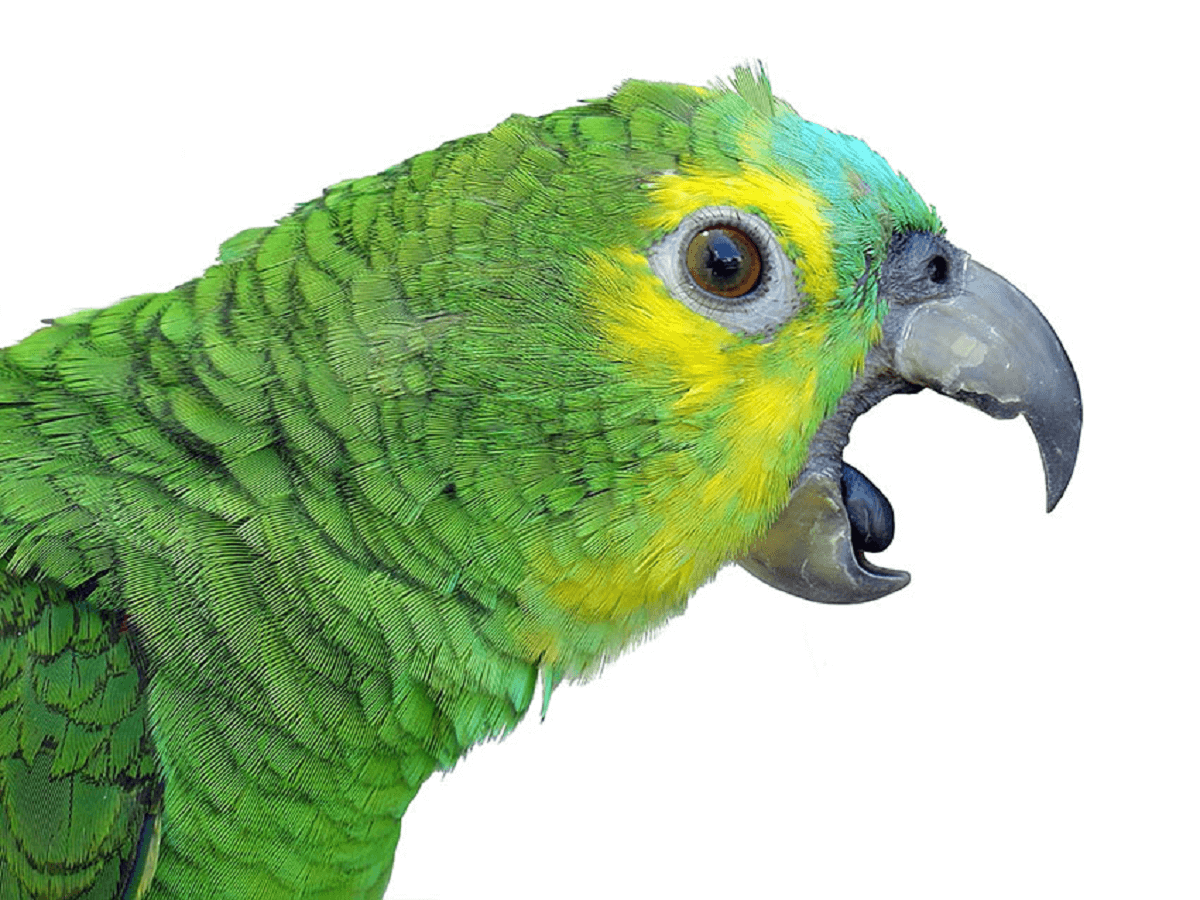
Aggressive African Grey
what about the animal Wanderers a while back I did and how-to on how to get a smaller bird to step on your finger and stay safely perched well we had to follow up a question that I’d like to tackle them now first one. See how you handle a larger Burleigh, cough and a second one was asking how do you handle an aggressive Amazon parrot I’ve had the exact same questions there are so many species of animals out there and within each species or discount with personalities it’s almost impossible for me to give advice without seeing the animals Behavior first so I’m going to do my best to get some general advice and ideas on certain situations first question was from hybrid Herbst you can read the full question here you can probably if you want to but the basic General concept how do I handle a larger bird so I would feel uncomfortable with one finger with a larger bird I would offer multiple fingers or Apollo up or my arm to stabilize their heavy weight and large feet did is similar to a small bird with a single finger perch you’re going to move slowly forward and approach your arm Palm fingers perch right even with their chest if you’re very comfortable with your large bird macaw coffee to go ahead and move that Purge all the way up to their chest if you’re still establishing a trust bond with that bird you want to present the perch and weight for them to show signs that they want to step onto the main sign of the bird wanting to step up is to raise our foot in the air and offer like this without painting of the eyes if it means course you may be with an open Beaker remove your part and try again in a moment remember you can’t make him a call do anything that they don’t want to do that I could just be grouchy but if you haven’t established at respond yet take a step back and work on your relationship building up feed them talk nice to them feed them trees to the bars and then when they’re out groom them through the bars and then when they’re out it could take time it’s a joy night about eight months to establish art respond delicious second question from laughing at the dark here’s the full text right here basically how do you work with an aggressive parrot that are bonded to you or aren’t very well socialized really difficult especially Amazon Parrots would have quite a spunky attitude laughing in the dark spirit I would not suggest putting my finger near that bird until you’re fairly confident he won’t bite the promise to creating a trust bond with associate degree aggressive Amazon it takes time it may take many years if ever this can be chongo and he’s a lilac topped
Amazon parrot lilac-crowned Amazon parrot and it took us about a year to create a trust bond enough that I was comfortable enough to pick him up and he was comfortable enough to stand comfortably on my hand and all the treats that he can eat this is r.j. he’s a blue-fronted Amazon parrot and we’re still working on our trust bond I use precautions when I work with him this is how I approach this situation
Aggressive African Grey
SOURCE:wingsNpaws
Why Your Parrot Bites & How to Stop It
I would use a handheld stick to use at a purge so I keep my hands safe and then you always want to be able to offer them treats so I would use a spoon or you can go ahead and just put it in a bowl so I would show him the perch and we’ve already established this relationship already this so he would step up onto the porch and then you can use a spoon to give the treats so this allows you to stay safe allows you to make sure that he doesn’t get nervous if he does bite you and you can still work on establishing your relationship together he gets treats you work on stepping up win win situation as far as me and Archie have gone in our relationship so far is going quite well the next step is going to be me and moving my hand down the Persian getting closer to him now if at any point he does bite me do my best not to react don’t react to a bird bite by saying ouch or yelling or anything like that quickly and calmly remove yourself from the situation reacting to any behavior of your bird is going to increase the chance of it occurring again so you don’t want it to happen again remove yourself your attention any potential interesting or positive things remove that and the likelihood of that behavior happen again is going to decrease down laughing in the dark with your Amazon parrot try using the stick and the spoon make all your interactions positive good luck and now here’s just a couple more tips for tricky situations with birds my bird won’t come out of cage open the door let him come out on his own maybe he’ll come on top of his home maybe he’ll just come out on the top of the door the both are fine maybe even put a little ball on top but the treats in there and Tyson out that way for me if they’re running away mean you haven’t spent enough time on your trust bond with them take a step back make some more interactions with yourself positive lots of treats no pressure if they’re just playing games with you put your hand behind them and encourage them to come toward your finger my bird is biting me all the time citizens use their beak to explore and communicate so either they’re just trying to figure out what the hard thing is inside your finger or the try to tell you something listen are they nervous are they scared or something out the window that scaring them is your cat staring at them respond appropriately help them out listen to what they’re saying my bird won’t stay on my finger while either bored or they’re too nervous they’re bored give him something fun to do on your finger so nervous take a step back and reinvest in your trust bond my bird is scared of my hand start offering treats for the spoon or tweezers start establishing a positive relationship with your hand in your fingers and also get them onto the floor and offer flat back of the hand for them to step onto or even a finger from the floor bird only want to get to the highest perch so that’s a good way to start establishing your finger and the two most important thing you can do for your bird is to listen to what they’re telling you body language is key to their communication. What your trust fund and then use these tips I shared help navigate a healthy interactive relationship with your Feathered Friends

